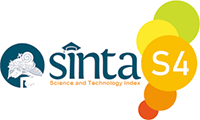Perbedaan faktor resiko penyebab stroke pada lansia dan remaja
Differences in risk factors for stroke in the elderly and adolescents
DOI:
 https://doi.org/10.36376/bmj.v9i3.281
https://doi.org/10.36376/bmj.v9i3.281
Keywords:
Penyebab stroke, Stroke pada lansia dan remaja, Resiko strokeAbstract
Stroke tidak hanya terjadi pada kelompok usia tua, namun banyak kasus yang terjadi pada usia remaja. Faktor resiko stroke yang terjadi pada lansia hampir sama dengan faktor resiko yang terjadi pada remaja. Tujuan literatur review ini adalah untuk mengetahui perbedaan faktor resiko stroke pada usia remaja dan lansia. Metode penelitian adalah tradisional review dengan kriteria inklusi artikel dari jurnal nasional dan internasional yang terkait variabel, dengan desain penelitian kohort dan cross sectional yang terbit 10 tahun terakhir. Hasil penelitian didapatkan hipertensi menjadi penyebab stroke yang terbanyak pada usia lansia dan remaja dengan nilai p=value <0,001, hiperglikemia/diabetes mellitus, merokok, hiperlipidemia, plak karotis dan kardiomiopati juga merupakan faktor resiko stroke pada lansia dan remaja memiliki nilai p=value <0,001. Kurang olahraga dan obesitas menjadi faktor resiko stroke pada remaja yang tidak ditemukan lansia, sedangkan usia merupakan faktor risiko lansia dan tidak merupakan faktor risiko stroke pada remaja. Dapat disimpulkan hipertensi merupakan faktor risiko stroke dominan pada remaja dan lansia disamping diabetes melitus, merokok, hiperlipidemia, kardiomiopati dan plak karotis.
Stroke does not only occur in the old age group, but many cases occur in adolescents. The risk factors for stroke that occur in the elderly are almost the same as the risk factors that occur in adolescents. The purpose of the literature is to determine the risk factors for stroke in adolescents and the elderly. The research method is a traditional review with the inclusion criteria of articles from national and international journals related to variables, with a cohort and cross-sectional research design published in the last 10 years. The results showed that hypertension was the most common cause of stroke in the elderly and adolescents with p = value <0.001, hyperglycemia/diabetes mellitus, smoking, hyperlipidemia, carotid plaque and cardiomyopathy were also risk factors for stroke in the elderly and adolescents having p = value < 0.001. Lack of exercise and obesity are risk factor for stroke in adolescents but are not found in the elderly, while age is a risk factors for the elderly and is not risk factor for stroke in adolescents. It can be concluded that hypertension is the dominant stroke risk factor in adolescents and the elderly in addition to diabetes mellitus, smoking, hyperlipidemia, cardiomyopathy and carotid plaque
Downloads
References
Aly Z, Abbas K, Kazim SF , Taj F , et al. (2009). Awareness of Stroke Risk Factors, Signs and Treatment in A Pakistani Population. Journal Pakistan Medical Association. 59(7): 495-499.
Bray, J E. (2011). Factors Related to Prehospital Delay in Stroke. Thesis. Deakin University
Budi, Hendri; Bahar, Indrawati; Sasmita, Heppi. (2018). Faktor Risiko Stroke Pada Usia Produktif Di Rumah Sakit Stroke Nasional (RSSN) Bukit Tinggi. Jurnal Persatuan Perawat Nasional Indonesia.3(3). https://doi.org/10.32419/jppni.v3i3.163
Diananda, Amita. (2018). Psikologi Remaja dan Permasalahannya. ISTIGHNA. 1(1), 113-133. https://doi.org/10.33853/istighna.v1i1.20
Essouma, Mickael; Noubiap,J.J. N; Jean Joel R Bigna, J.J.R; Nansseu,J.R.N; Jingi, A.M; Aminde,Leopold.N; and Zafack, Joseline. (2015). Hypertension prevalence, incidence and risk factors among children and adolescents in Africa: a systematic review and meta-analysis protocol. BMJ Open. 5 (9), 1-5. https://doi.org/10.1136/bmjopen-2015-008472
Feigin, V.L; Brainin, M; Norrving, B; Martins, S; Sacco, R.L; Fisher, M;Pandian, J; Lindsay, P. (2022). World Stroke Organization (WSO): Global Stroke Fact Sheet 2022. International Journal of Stroke. 17(1), 18-29. https://doi.org/10.1177/17474930211065917
Fitriani, Nur; Fitriani; Siswanto, Yuliaji; Siswanto; Puji, I; Lestari. (2020). Faktor Risiko Kejadian Hipertensi pada Remaja di Kecamatan Bergas. Universitas Ngudi Waluyo, Tidak dipublikasikan
Haynes, M.J; Vincent, K; Fishhoff, C; Bremner, A.P; Lanlo, O; Hankey, G.J. (2012). Assessing the risk of stroke from neck manipulation: a Systematic review. International Journal of Clinical Practice. 66(10), 940-947. https://doi.org/10.1111/j.1742-1241.2012.03004.x
Huggins, Haley.E; Brady, Merrill; Emma, Jost-Price; Thaler, David.E; Leung, Lester.Y. (2020). Differences in Presenting Symptoms of Acute Stroke Among. Journal of Stroke and Cerebrovascular Diseases. 29 (8),104871. https://doi.org/10.1016/j.jstrokecerebrovasdis.2020.104871
Kono, Yuji ;; Kawajiri, Hiroyuki; Kamisaka, Kenta; Kamiya, Kuniyasu; Akao, Keigo; Asai, Chikako; Kana, Inuzuka; Yamada, Sumio. (2014). Predictive impact of daily physical activity on new vascular events in patients with mild ischemic stroke. Intenational Journal Stroke. 10(2), 219-223. https://doi.org/10.1111/ijs.12392
Luqman, Vincha Rahma. (2020). Komplikasi Pada Jantung dan Abnormalitas Pasca Stroke. Jurnal Ilmiah Mahasiswa Kedokteran Indonesia. 7(2). https://doi.org/10.53366/jimki.v7i2.57
Mahendrakrisna, Daniel; Windriya, Drestha Pratita; Chandra, Aria. (2019). Karakteristik Pasien Stroke Usia Muda di RSUD Kota Surakarta. CDK-274. 46(3), 167-170.
Meschia, James, Chair, Bushnell, Cheryl, Boden-Albala, Braun, Lynne, Bravata, Dawn, . . . Creager. (2014). Guidelines for the Primary Prevention of Stroke A Statement for Healthcare Professionals From the American Heart Association/American Stroke Association. American Heart Association, 45, 3754-3832. https://doi.org/10.1161/str.0000000000000046
McGrath, Emer, Kapral, Moira, Fang, Jiming, Conghaile, Canavan, Michlle, & O’Donnell. (2012). Which Risk Factors Are More Associated With Ischemic Stroke Than Intracerebral Hemorrhage in Patients With Atrial Fibrillation?. American Heart Association, 43, 2048-2054. https://doi.org/10.1161/strokeaha.112.654145
Mitchell, A.B; Cole, J.W; McArdle, P.F; Cheng, Yu-Ching; Ryan, K.A; Sparks, M.J; Mitchell, B.D; Kittner, S.J.(2015). Obesity Increases Risk of Ischemic Stroke in Young Adults. Stroke. 46(6), 1690-1692. https://doi.org/10.1161/strokeaha.115.008940
Nurhidayat, Saiful. (2014). Faktor Risiko Penyakit Kardiovaskuler pada Remaja di Ponorogo. Dunia Keperawatan. 2(2), 40-48. DOI: http://dx.doi.org/10.20527/dk.v2i2
O’Donnell, Xavier, Dennis, Liu, Lisheng, Zhang, Hongye, Chin, Siu Lim, Purnima, Rao-Melacini, . . . Shofi qul Islam. (2010). Risk Factors for Ischaemic and Intracerebral Haemorrhagic Stroke in 22 Countries (the INTERSTROKE study): a Case-control Study. Lancet, 376, 112–123. https://doi.org/10.1016/s0140-6736(10)60834-3
Pudjiastuti, Sri Surini. (2003). Fisioterapi pada Lansia. ECG:Jakarta
Park, T.H; Ko, Youngchai; Lee, Soo Joo; Lee, Kyung Bok; Lee, Jun; Han, Moon-Ku; Park, Jong-Moo; Kim, Dong-Eog; Cho, Yong-Jin; Hong, Keun-Sik; Kim, Joon-Tae; Cho, Ki-Hyun; Kim, Dae-Hyun; Cha, Jae-Kwan; Yu, Kyung-Ho; Lee, Byung-Chul; Yoon, Byung-Woo.......Bae, Hee-Joon. (2014). Gender differences in the age-stratified prevalence of risk factors in Korean. International Journal of Stroke. 9(6), 759-765. https://doi.org/10.1109/isscc.1996.488725
Ramadany, Aulya.F; Pujarini, Listyo.A; Candrasari, Anika. (2013). Hubungan Diabetes Melitus Dengan Kejadian Stroke Iskemik Di RSUD Kejadian Stroke Iskemik Di Rsud Tahun 2010.Biomedika. 5(2), 11-16. https://doi.org/10.23917/biomedika.v5i2.264
Tang, Mingyu; Han, Guangsong; Yao, Ming; Peng, Bin; Zhu, Yicheng; Zhou, Lixin; Ni,Jun. (2022). Risk Factors of Ischemic Stroke in Young Adults: A Chinese Single-Center Study. Frontiers in Neurology, 13, 1-8. https://doi.org/10.3389/fneur.2022.874770
Venketasubramanian, Na; Woo Yoon, B; Pandian, Navarrod, J.C. (2017). Stroke Epidemiology in South, East, and South-East Asia: A Review. Journal of Stroke. 19 (3), 286-294. https://doi.org/10.5853/jos.2017.00234
Wardhani, N.R & Martini, S. (2014). Faktor yang berhubungan dengan Pengetahuan tentang Stroke pada Pekerja Institusi Pendidikan Tinggi. Jurnal Berkala Epidemiologi. 2(1): 13-23. https://doi.org/10.20473/jbe.v2i1.2014.13-23
World Heart Organization. (2020). NonCommunicable Disease. Diunduh di https://platform.who.int/mortality/themes/theme-details/mdb/noncommunicable-diseases
Badan Penelitian dan Pengembangan Kesehatan Kementrian Kesehatan RI. (2018). Riset Kesehatan Dasar 2018. Jakarta: Badan Penelitian dan Pengembangan Kesehatan Kementerian Kesehatan RI. https://doi.org/10.14203/press.298
Zhang , Qiuling; Liu, Yao; Jiang, Min; Liu, Yun; Gu Shuangshuang; Tong, Hanwen. (2020). Temporal Trends in the Risk Factors and Clinical Characteristics. Journal Stroke Cerebrovasculer Disease. 29(8). https://doi.org/10.1016/j.jstrokecerebrovasdis.2020.104914
Downloads
Published
How to Cite
Issue
Section
License
Copyright (c) 2022 Dewi Rachmawati, Cindy Marshela, Imam Sunarno

This work is licensed under a Creative Commons Attribution 4.0 International License.


















